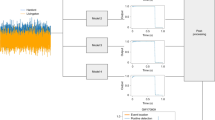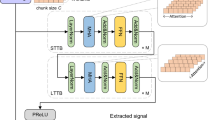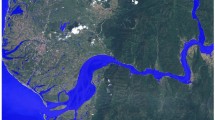Abstract
Computational demands in gravitational-wave astronomy are expected to at least double over the next five years. As kilometre-scale interferometers are brought to design sensitivity, real-time delivery of gravitational-wave alerts will become increasingly important to enable multimessenger follow-up. Here we discuss a novel implementation and deployment of deep learning inference for real-time data denoising and astrophysical source identification. This objective is accomplished using a generic inference-as-a-service model capable of adapting to the future needs of gravitational-wave data analysis. The implementation allows seamless incorporation of hardware accelerators and also enables the use of commercial or private as-a-service computing. Low-latency and offline computing in gravitational-wave astronomy addresses key challenges in scalability and reliability and provides a data analysis platform particularly optimized for deep learning applications.
This is a preview of subscription content, access via your institution
Access options
Access Nature and 54 other Nature Portfolio journals
Get Nature+, our best-value online-access subscription
$29.99 / 30 days
cancel any time
Subscribe to this journal
Receive 12 digital issues and online access to articles
$119.00 per year
only $9.92 per issue
Buy this article
- Purchase on Springer Link
- Instant access to full article PDF
Prices may be subject to local taxes which are calculated during checkout






Similar content being viewed by others
Data availability
The datasets generated during and/or analysed during the current study are available from the corresponding author on reasonable request.
Code availability
All code used to generate the data for both the online and offline experiments in this study is available at https://github.com/fastmachinelearning/gw-iaas.
References
Dietrich, T. et al. New constraints on the supranuclear equation of state and the Hubble constant from nuclear physics—multi-messenger astronomy. Science 370, 1450–1453 (2020).
Aartsen, M. G. et al. Multimessenger observations of a flaring blazar coincident with high-energy neutrino IceCube-170922A. Science 361, eaat1378 (2018).
Abbott, B. P. et al. Observation of gravitational waves from a binary black hole merger. Phys. Rev. Lett. 116, 061102 (2016).
Abbott, B. et al. GW170817: observation of gravitational waves from a binary neutron star inspiral. Phys. Rev. Lett. 119, 161101 (2017).
Harry, G. M. et al. Advanced LIGO: the next generation of gravitational wave detectors. Class. Quantum Gravity 27, 084006 (2010).
Aasi, J. et al. Advanced LIGO. Class. Quantum Gravity 32, 074001 (2015).
Acernese, F. et al. Advanced Virgo. Class. Quantum Gravity 32, 024001 (2015).
Abbott, B. P. et al. Prospects for observing and localizing gravitational-wave transients with Advanced LIGO, Advanced Virgo and KAGRA. Living Rev. Relativ. 23, 3 (2020).
Usman, S. A. et al. The PyCBC search for gravitational waves from compact binary coalescence. Class. Quantum Gravity 33, 215004 (2016).
Cannon, K. et al. GstLAL: a software framework for gravitational wave discovery. Preprint at https://arxiv.org/abs/2010.05082 (2020).
Abbott, B. et al. Search for subsolar mass ultracompact binaries in Advanced LIGO’s second observing run. Phys. Rev. Lett. 123, 161102 (2019).
Aso, Y. et al. Interferometer design of the KAGRA gravitational wave detector. Phys. Rev. D 88, 043007 (2013).
Somiya, K. Detector configuration of KAGRA—the Japanese cryogenic gravitational-wave detector. Class. Quantum Gravity 29, 124007 (2012).
Zevin, M. et al. Gravity Spy: integrating advanced LIGO detector characterization, machine learning, and citizen science. Class. Quantum Gravity 34, 064003 (2017).
Davis, D. et al. LIGO detector characterization in the second and third observing runs. Class. Quantum Gravity 38, 135014 (2021).
Cuoco, E. et al. Enhancing gravitational-wave science with machine learning. Mach. Learn. Sci. Technol. 2, 011002 (2021).
Vajente, G. et al. Machine-learning nonstationary noise out of gravitational-wave detectors. Phys. Rev. D 101, 042003 (2020).
Ormiston, R., Nguyen, T., Coughlin, M., Adhikari, R. X. & Katsavounidis, E. Noise reduction in gravitational-wave data via deep learning. Phys. Rev. Res. 2, 033066 (2020).
George, D. & Huerta, E. A. Deep learning for real-time gravitational wave detection and parameter estimation: results with Advanced LIGO data. Phys. Lett. B 778, 64–70 (2018).
Schäfer, M. B. & Nitz, A. H. From one to many: A deep learning coincident gravitational-wave search. Phys. Rev. D 105, 043003 (2022).
Green, S. R., Simpson, C. & Gair, J. Gravitational-wave parameter estimation with autoregressive neural network flows. Phys. Rev. D 102, 104057 (2020).
Gabbard, H., Messenger, C., Heng, I.S. et al. Bayesian parameter estimation using conditional variational autoencoders for gravitational-wave astronomy. Nat. Phys. 18, 112–117 (2022).
Mukund, N., Abraham, S., Kandhasamy, S., Mitra, S. & Philip, N. S. Transient classification in LIGO data using difference boosting neural network. Phys. Rev. D 95, 104059 (2017).
Mittal, S. & Vetter, J. S. A survey of CPU–GPU heterogeneous computing techniques. ACM Comput. Surv. 47, 69 (2015).
Duarte, J. et al. FPGA-accelerated machine learning inference as a service for particle physics computing. Comput. Softw. Big Sci. 3, 13 (2019).
Caulfield, A. et al. A cloud-scale acceleration architecture. In Proc. 49th Annual IEEE/ACM International Symposium on Microarchitecture (IEEE, 2016).
Sfiligoi, I. et al. Expanding IceCube GPU computing into the Clouds. In 2021 IEEE 17th International Conference on eScience (eScience) 227–228 (IEEE, 2021).
Wang, M. et al. GPU-Accelerated Machine Learning Inference as a Service for Computing in Neutrino Experiments. Front. Big Data 3 (2021).
Krupa, J. et al. GPU coprocessors as a service for deep learning inference in high energy physics. Mach. Learn. Sci. Technol. 2, 035005 (2021).
Rankin, D. et al. FPGAs-as-a-Service Toolkit (FaaST). In 2020 IEEE/ACM International Workshop on Heterogeneous High-performance Reconfigurable Computing (H2RC) 38–47 (IEEE, 2020).
Abbott, B. P. et al. Characterization of transient noise in Advanced LIGO relevant to gravitational wave signal GW150914. Class. Quantum Gravity 33, 134001 (2016).
Triton Inference Server v.2.12.0 https://developer.nvidia.com/nvidia-triton-inference-server (NVIDIA, 2021).
Abadie, J. et al. First low-latency LIGO+Virgo search for binary inspirals and their electromagnetic counterparts. Astron. Astrophys. 541, A155 (2012).
Nitz, A. H., Dal Canton, T., Davis, D. & Reyes, S. Rapid detection of gravitational waves from compact binary mergers with PyCBC Live. Phys. Rev. D 98, 024050 (2018).
Abbott, R. et al. Search for gravitational waves associated with gamma-ray bursts detected by Fermi and Swift during the LIGO–Virgo run O3a. Astrophys. J. 915, 86 (2021).
Usman, S. A. et al. The PyCBC search for gravitational waves from compact binary coalescence. Class. Quantum Gravity 33, 215004 (2016).
Abbott, R. et al. GWTC-2: compact binary coalescences observed by LIGO and Virgo during the first half of the third observing run. Phys. Rev. X 11, 021053 (2021).
Holzman, B. et al. HEPCloud, a new paradigm for HEP facilities: CMS Amazon Web Services investigation. Comput. Softw. Big Sci. 1, 1 (2017).
Reitze, D. et al. Cosmic Explorer: The U.S. Contribution to Gravitational-Wave Astronomy beyond LIGO. Bull. Am. Astron. Soc. 51 (2019).
Kurtzer, G. M. et al. hpcng/singularity: singularity 3.7.3. https://zenodo.org/record/1310023 (2021).
Acknowledgements
We are grateful for computational resources provided by the LIGO Laboratory at Caltech, Livingston, LA, and Hanford, WA. The LIGO Laboratory has been supported under National Science Foundation (NSF) grants PHY-0757058 and PHY-0823459. A.G., D.R., T.N., P.H. and E.K. are supported by NSF grants 1934700 and 1931469, and D.R. additionally by the IRIS-HEP grant 1836650. J.K. is supported by NSF grant 190444. M.S. and M.C. are supported by NSF grant PHY-2010970. Work supported by the Fermi National Accelerator Laboratory, managed and operated by Fermi Research Alliance, LLC under contract DE-AC02-07CH11359 with the US Department of Energy. The US Government retains and the publisher, by accepting the article for publication, acknowledges that the US Government retains a non-exclusive, paid-up, irrevocable, world-wide license to publish or reproduce the published form of this manuscript, or allow others to do so, for US Government purposes. Cloud credits for this study were provided by the Internet2-managed Exploring Clouds for Acceleration of Science (NSF grant PHY-190444). Additionally we would like to thank the NSF Institute for AI and Fundamental Interactions (cooperative agreement PHY-2019786). We are also grateful for the support provided by S. Anderson in the realization and testing of our workflow within the LDG. Finally, we thank A. Pace for providing useful comments on the manuscript.
Author information
Authors and Affiliations
Contributions
A.G. and D.R. are the primary authors of the manuscript. J.K. integrated applications in HEPCloud. S.T. and B.H. support and operate HEPCloud. M.S., M.C., E.K. and T.N. support development of DeepClean. All authors contributed to editing of the manuscript.
Corresponding authors
Ethics declarations
Competing interests
The authors declare no competing interests.
Peer review
Peer review information
Nature Astronomy thanks Alexander Nitz and the other, anonymous, reviewer(s) for their contribution to the peer review of this work.
Additional information
Publisher’s note Springer Nature remains neutral with regard to jurisdictional claims in published maps and institutional affiliations.
Supplementary information
Supplementary Information
Supplementary Discussion including Supplementary Fig. 1.
Rights and permissions
About this article
Cite this article
Gunny, A., Rankin, D., Krupa, J. et al. Hardware-accelerated inference for real-time gravitational-wave astronomy. Nat Astron 6, 529–536 (2022). https://doi.org/10.1038/s41550-022-01651-w
Received:
Accepted:
Published:
Issue Date:
DOI: https://doi.org/10.1038/s41550-022-01651-w



